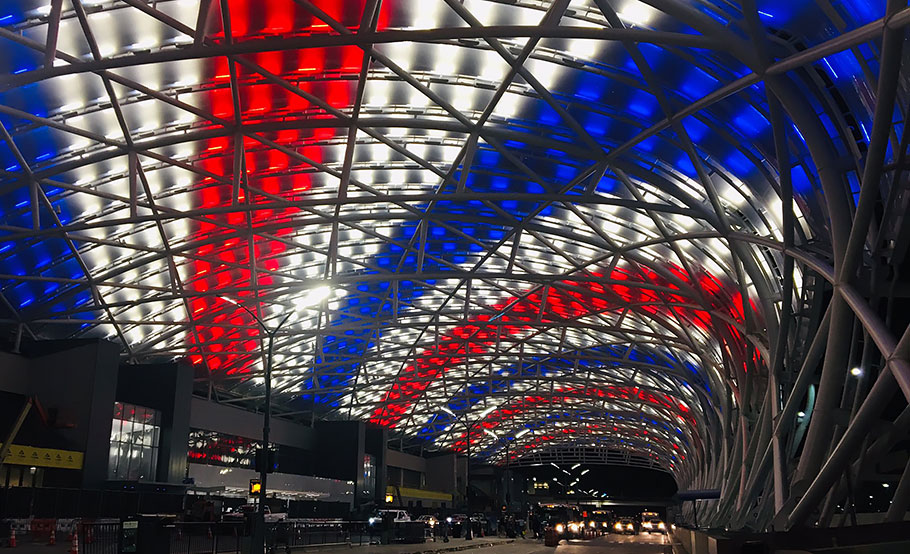
FabriTec Structures has completed a pair of immense tensile membrane structures designed to cover the arrival and departure domestic terminal of the Hartsfield-Jackson Atlanta International Airport. The structures are a part of ATLNext, a 20-year project at Hartsfield-Jackson that consists of a series of improvements designed to boost capacity, renew and replace existing facilities, and enhance aesthetic appeal.
The massive tensile membrane structures cover both the north and south sides of the domestic terminal with 194-foot-wide, 874-foot-long ETFE canopies. Each canopy, soaring 72 feet above the 8 lanes of traffic and pedestrians below, is made from ethylene tetrafluoroethylene (ETFE) and supported by over 1700 tons of steel and aluminum. The canopy consists of two layers of the ETFE, with the space between inflated to give the structure a pillow-like appearance, connected by a network of aluminum extrusions.
Construction started on the north structure in October 2017, with the south structure beginning a year later in October 2018. Combined, the two canopies span 345,500 square feet and contain over 3500 tons of steel. The ETFE canopies help bring a modern feel to the domestic terminal.
“We wanted to bring the remaining concourses and domestic terminal up to the same standard as the new international terminal,” says Todd McClendon, director of central passenger terminal complex (CTPC) projects. “That includes exterior modernization of the domestic terminal with canopies and facades.”
Hartsfield-Jackson was the world’s busiest airport for the 21st consecutive year in 2018, with over 104 million passengers annually. Those arriving by car or plane will see the massive canopies anytime but will see an enhanced display after sundown. Each canopy contains 1,938 pre-programmed LED lights. The airport can choose from a variety of colors for each light, allowing for an aesthetically pleasing experience for travelers. The lights can be programmed to display patterns for holidays, events, and more. The canopies aren’t only for appearance, though.
Jorge Cortes, ATL assistant director of Planning and Development, said of the terminals before the canopies were constructed, “When it now rains, there are sheets of water that come down on those unloading a car, and you really get wet. By providing the canopy, we really provide an increased level of service for all our passengers.”
The new canopies extend all the way to the nearby parking garages, providing a dry journey for those parking or picking up a car, as well as those being dropped off or picked up. The canopies also reduce maintenance, because crews no longer need to constantly mop up water being tracked into the domestic terminal during storms.
Construction on the canopy structures was uniquely challenging, due to the pedestrian presence. The world’s busiest airport couldn’t simply shut down to install the canopy structures. Instead, the construction had to work around the roads, entryways, and pedestrian areas, attempting to inconvenience as few people as possible.
“We knew we couldn’t leave areas closed at the face of the building where people flowed in and out during the day. So, we worked with the design team to engineer the connections in the canopy trusses in a way that allowed us to build them in nightly shifts,” said NSMS Senior Project Manager Justis Brogan.
“To facilitate the safe and controlled erection of these canopies, we had to shut down entire roadways, implement traffic control systems, close certain vestibule entrances and exits to allow overhead work to occur during non-peak hours, and reroute the way passengers arrived to terminals from parking decks or drop-off vehicles,” added Cameron Hudson, NSMS Project Manager.





